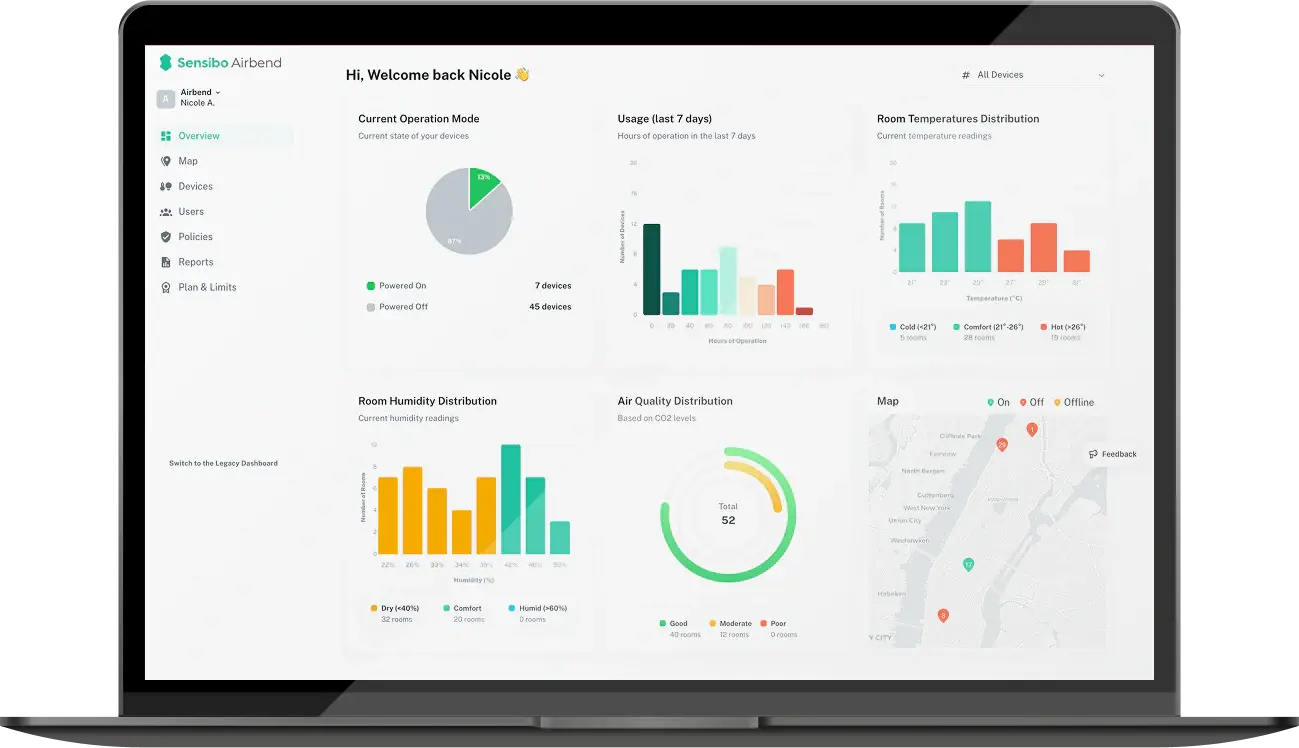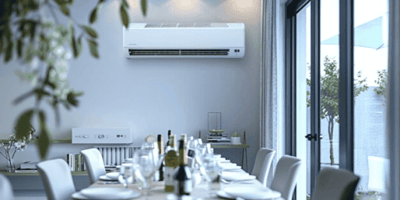Dorm Room Air Conditioner: How to Stay Cool Without Breaking the Rules
Key Takeaways
- Your school's housing policy determines what cooling options you actually have - check before you buy
- Most standard dorm rooms need 8,000-10,000 BTU units, but smaller spaces work fine with less power
- Evaporative coolers and smart fan setups can match portable AC performance in many situations
- Where you place your cooling device matters more than you'd think
- Smart controllers slash electricity costs while keeping you comfortable
Every university has its own approach when it comes to cooling policies in dorm rooms, and it’s crucial to understand these before you make any decisions. Older dormitories weren’t built to accommodate energy-consuming appliances like personal air conditioners. On top of that, fire safety regulations and concerns about sky-high utility bills make many universities wary of allowing such devices.
Some institutions ban air conditioners altogether, while others permit portable units with specific restrictions, such as limits on BTU ratings or the requirement to register the appliance through housing services. Newer dorms with updated electrical systems might have more relaxed rules, but it’s always best to check first.
For students with medical conditions requiring climate control, options might be available through disability services, but expect to follow a formal process and potentially pay extra fees.
If you break the rules, the consequences can be costly—housing staff could confiscate your air conditioner, fine you, and even mark your housing record. The policies vary, so it’s important to get clarity from your RA or the official handbook before making any purchases.
This guide will help you navigate your university’s cooling device policies, choose the right air conditioner for your dorm room, and explore alternatives if AC isn’t an option. Whether it’s understanding your university’s rules or finding creative ways to stay cool, we’ve got you covered.
Understanding Your University's AC Rules
Every school handles cooling device policies differently, and trust me, they have reasons. Older dorms weren't designed for dozens of energy-hungry appliances. Add fire safety codes and utility bills that would make administrators cry, and suddenly those restrictions make sense.
Some universities ban everything except desk fans. Others allow portable units but cap them at specific BTU limits or require registration through housing services. Newer residence halls often have more relaxed policies since their electrical systems can handle the load.
Students dealing with medical conditions that require climate control have options through disability services. You'll need documentation from your doctor, and expect to pay extra fees for installation and electricity. The process takes weeks, so start early if this applies to you.
Here's what happens when you ignore the rules: housing staff will find your contraband cooler during routine inspections. They'll confiscate it, possibly fine you, and definitely put a mark on your housing record. Some schools hold your stuff until move-out day. Others make you retrieve it immediately or lose it forever.
Your RA knows the real deal about what's allowed and what housing staff actually care about. The official handbook might say one thing, but enforcement varies wildly between buildings and staff members.
Choosing the Right Portable Air Conditioner for Dorm Room
Shopping for a portable air conditioner for dorm room use means navigating BTU ratings, window types, and noise levels while staying within your budget and housing rules.
BTU capacity determines whether you'll actually feel cool or just hear expensive humming. Too small means you're wasting money on a glorified fan. Too big means constant cycling that never properly dehumidifies your space.
BTU Sizing Guide for Dorm Rooms:
- Tiny single rooms (under 150 sq ft): 5,000-6,000 BTU handles it
- Standard single/double (150-350 sq ft): 8,000 BTU hits the sweet spot
- Large doubles or suites (350-450 sq ft): 10,000 BTU keeps everyone happy
- Apartment-style housing (450+ sq ft): 12,000+ BTU or you're fighting physics
Window compatibility trips up lots of students. Most dorm room air conditioner units expect those standard horizontal sliding windows. Got weird casement windows that crank open? You'll need special adapter kits that might not fit your space properly.
Noise becomes a huge issue when you're sharing tight quarters. Anything over 50 decibels starts annoying people trying to sleep or study. Quality units run between 40-48 decibels, which sounds like quiet background chatter.
Energy efficiency ratings determine whether your electricity bill resembles a car payment. Higher EER numbers mean better efficiency. A cheap 8,000 BTU unit might cost $50 monthly to run, while an efficient model drops that to $30-35.
Single-hose systems cost less upfront but work harder and waste more energy. They suck indoor air and blow it outside, creating negative pressure that pulls hot outdoor air through every crack and gap. Dual-hose systems separate the intake and exhaust functions, maintaining much better efficiency.
Budget-conscious students can find solid 8,000 BTU units for $250-400. Premium models with smart features and whisper-quiet operation run $400-600. Calculate total ownership costs including electricity over a full academic year.

Installation and Setup Without Damaging Property
Getting your cooling system running without triggering housing violations requires some finesse. Universities hate permanent modifications, so everything needs to be reversible.
Window installation kits include adjustable panels for different window sizes. Measure your window opening first - standard kits fit 23-36 inch openings. Install panels firmly but don't over-tighten screws that could crack frames or leave marks.
Position your air conditioner for dorm room near the window but out of walking paths. Give it 12-18 inches of breathing room on all sides. Avoid stuffing it under lofted beds where hot air gets trapped.
Condensation happens with all cooling systems. Modern units usually handle this automatically, but older models need drainage setup. Use the included hose and direct water somewhere safe - never let it puddle on floors where it creates mold problems.
Roommate coordination prevents conflicts before they start. Discuss temperature preferences, noise tolerance, and cost-sharing arrangements upfront. Set usage schedules that respect different sleep and study habits.
Alternative Cooling Solutions When AC Isn't Allowed
When your school bans traditional air conditioning, creative alternatives can still deliver serious temperature drops while staying within policy limits.
Evaporative coolers work like natural air conditioning, forcing hot air through water-soaked pads to create cooler, slightly more humid air. They excel in dry climates, potentially dropping room temperatures 10-15 degrees. Most housing policies allow them since they use 300-500 watts instead of the 2,000+ watts that AC units demand.
Strategic Fan Placement Techniques:
- Intake positioning: Box fans in shaded windows pull cooler outside air indoors
- Exhaust setup: Fans in sunny windows push hot indoor air outside
- Cross-ventilation: Multiple fans create airflow patterns through your space
- Ceiling fan optimization: Counterclockwise rotation pulls hot air up and away
Tower fans rock in cramped spaces because they're tall rather than wide, and most oscillate to cover more area. Desktop fans provide personal cooling zones without bothering roommates across the room.
The ice bowl hack turns any fan into makeshift air conditioning. Drop a bowl of ice water in front of your fan and let physics do the work - passing air picks up coolness from evaporation. This drops local temperatures 5-8 degrees for several hours per bowl.
Window treatments make huge differences in room temperature. Blackout curtains block solar heat during peak sun hours. Reflective films bounce sunlight away while you can still see outside. Thermal blinds create insulating air gaps that reduce heat transfer through glass.
Smart Technology and Energy Management
Cooling technology has evolved beyond basic on/off switches. Smart controllers from companies like Sensibo retrofit onto regular portable units, adding smartphone connectivity and automation that actually saves money on electricity bills.
These devices connect to existing portable AC units through infrared signals, giving you remote control and programming features. Set your unit to cool down 30 minutes before you return from class, ensuring comfort without running all day while you're gone.
Key Smart Controller Benefits:
- Geofencing technology: Automatically shuts off when you leave campus
- Custom scheduling: Different temperatures for sleep, study, and class times
- Energy tracking: Real-time electricity usage and cost monitoring
- Remote operation: Control from anywhere via smartphone app
Programming features work perfectly with college schedules. Run higher temperatures during class hours, then pre-cool before you return. This strategy cuts energy use 15-20% compared to constant operation while maintaining the same comfort levels.
Energy monitoring helps budget-conscious students avoid bill shock. Smart controllers show daily usage patterns, highlighting wasteful habits like cooling empty rooms or setting unnecessarily low temperatures.
Peak hour strategies reduce costs further. Many utility companies charge premium rates during high-demand periods (usually 3-7 PM). Smart controllers can temporarily raise temperatures during expensive hours, then resume normal cooling when rates drop.
.jpg?width=800&height=400&name=bunk-bed-modern-childrens-room-minimalist-apartment%20(1).jpg)
Room Optimization for Maximum Cooling
Effective cooling involves more than just adding cooling devices - you need to eliminate heat sources and optimize airflow patterns throughout your space.
Electronics pump out surprising heat. Desktop computers, gaming consoles, and phone chargers can raise room temperatures several degrees. Position heat-generating devices away from sleeping and study areas. Power strips with individual switches let you shut down unused devices selectively.
Lighting makes a bigger difference than most people realize. Old incandescent bulbs convert most electricity into heat rather than light. LED replacements use 75% less energy while generating almost no heat.
Bedding and Comfort Optimization:
- Natural fiber sheets: Cotton and linen breathe better than synthetic materials
- Cooling mattress toppers: Gel-infused or ventilated foam prevents heat buildup
- Breathable pillows: Bamboo fiber or buckwheat hulls stay cooler than traditional stuffing
- Lightweight covers: Ditch heavy comforters during warm months
Furniture placement affects airflow more than you'd expect. Don't block vents or fan airflow with desks and dressers. Elevate beds when possible to improve air circulation underneath. Keep closet doors open to prevent hot air pockets.
Humidity control amplifies cooling effectiveness. Humid air feels warmer than dry air at identical temperatures. Small dehumidifiers remove excess moisture, making rooms feel 3-5 degrees cooler. Skip activities that add humidity like steamy showers during peak heat hours.
Troubleshooting Common Issues
Even well-planned cooling systems hit snags. Knowing common problems and fixes prevents headaches and keeps you comfortable.
Inadequate cooling usually means wrong BTU sizing or installation problems. Undersized units struggle constantly without reaching target temperatures. Oversized units cycle frequently without removing humidity properly. Clogged air filters restrict airflow - clean or replace them monthly during heavy use.
Noise complaints require diplomatic solutions. Establish usage hours that work for everyone involved. Consider quieter alternatives like quality evaporative coolers or premium tower fans with lower decibel ratings. White noise apps can mask remaining fan sounds during sleep.
Electrical problems show up as tripped circuit breakers. Dorm electrical systems often share circuits between multiple rooms. Coordinate high-power device usage with neighbors, or request transfers to rooms with better electrical capacity.
Condensation creates moisture issues that promote mold growth. Verify proper drainage from portable units. Use moisture-absorbing packets in humid climates. Report persistent condensation to housing maintenance immediately before it becomes a bigger problem.
FAQ
Can I bring any type of air conditioner to my dorm room
Check your specific university's housing policy first since many schools restrict personal AC units due to electrical limitations. Portable units are usually the only allowed option where cooling devices are permitted at all.
What size dorm room air conditioner do I need?
Most single or double rooms (up to 450 sq ft) work well with 8,000-10,000 BTU portable units. Smaller spaces under 200 sq ft can get by with 5,000-6,000 BTU models.
Are evaporative coolers effective in dorm rooms?
Evaporative coolers excel in dry climates, potentially dropping temperatures 10-15 degrees. They're often allowed when traditional AC units aren't and use much less electricity.
How can I cool my dorm room without an air conditioner?
Strategic fan placement works wonders - try cross-ventilation setups, block sunlight with blackout curtains, use the ice bowl method, and open windows during cooler evening hours.
Will using a dorm room air conditioner increase my electricity bill significantly?
Typical 8,000 BTU portable units cost $30-50 monthly to operate, but smart controllers can cut that 15-20% through automated scheduling and temperature management.
What should I do if my roommate complains about AC noise?
Look for units rated under 50 decibels, establish agreed-upon usage hours, or switch to quieter alternatives like evaporative coolers or high-quality tower fans.


































-min.jpg)


.jpg?height=200&name=photo_2024-07-05_21-25-23%20(1).jpg)



